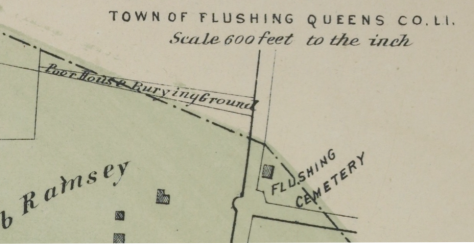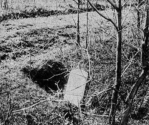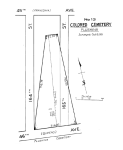
In 1839, an act of the New York State legislature authorized the town of Flushing, Queens, to tax its inhabitants for the “purpose of purchasing a suitable piece of land for a public burial ground.” The sum of $500 was to be collected to purchase property for the cemetery, which was to be deeded to the supervisor of the town of Flushing and “used as a public burial ground for said town.” A roughly triangular area of farmland in the southeastern part of Flushing was acquired for this purpose and was used as a public cemetery until 1898, when Flushing consolidated into the City of New York and the site became city property.

Located north of present-day 46th Avenue between 164th and 165th Streets, Flushing’s three-acre public cemetery served as a burial ground for the indigent and unknown and for those dying of contagious diseases. When first established, it likely also served as a general community cemetery where any local resident without a private family burial ground or church plot could be buried; this use was superseded in 1853 by the opening of the large, privately-owned Flushing Cemetery immediately opposite the public burial ground, on the south side of 46th Avenue. By the late 19th century, Flushing’s town cemetery was used primarily as a potter’s field and as a burial ground for the local African American community.

At a meeting of the Town of Flushing’s board of trustees in May 1895, a committee described their visit to the town cemetery, where they found it “sadly in need of attention.” Fences were down, the grounds were overgrown with weeds, and graves were dug haphazardly “wherever the gravedigger happened to first strike his spade.” Coffins were found two or three in a grave and sometimes no more than three feet beneath the surface. A year later, the Long Island Democrat reported that conditions in the town cemetery had “by no means improved…Bodies are indiscriminately buried only 6 to 12 inches below the ground just as in previous years.” In 1914, the abandoned cemetery site was acquired by the Parks Department and later converted into a public park and playground known as Martin’s Field.

Though an estimated 1,000 individuals were interred in Flushing’s town cemetery between 1840 and 1898, only four gravemarkers were found at the site in 1919 when it was surveyed by the Queens Topographical Bureau. Identifying the site as the “Colored Cemetery” the Topographical Bureau recorded the inscriptions on the marble tombstones of Willie Curry (d. 1874), Alfred Bunn (d. 1876), George Bunn (d. 1887), and James Bunn (d. 1890). The Bunns were of Native American ancestry and were members of Macedonia A.M.E. Church, a hub for Flushing’s nineteenth-century African American community.

There is no evidence that the burials in the Flushing town cemetery were removed when the site was converted into a public park, but human remains have been disturbed during the process of building facilities there. In 1936, “bones galore” were uncovered during excavations for a children’s wading pool, when neighbors “saw workmen pulling bones out of the ground.” In addition to human remains, the workers found pennies placed on the eyes of the dead—a burial practice also observed in excavations of the African Burial Ground in lower Manhattan.
 Rediscovery of the Flushing town cemetery began in the 1990s during planned renovations at Martin’s Field, when local activist Mandingo Tshaka drew attention to its previous history. Documentary research confirmed the park was a former public burial ground and that human remains likely were still present at the site. The Parks Department, spurred by community involvement, took steps to protect and recognize the former cemetery. Renovations completed in 2006 included a paved area with a central stone inscribed with the site’s history, and a recreated historic wall engraved with the names from the four headstones remaining here in 1919. The park was officially renamed “The Olde Town of Flushing Burial Ground” in 2010, and has since been listed on the New York State and National Register of Historic Places. In October 2018, city officials unveiled a $1.6 million plan to reconstruct the commemorative plaza and other features of the site, to better honor those laid to rest here.
Rediscovery of the Flushing town cemetery began in the 1990s during planned renovations at Martin’s Field, when local activist Mandingo Tshaka drew attention to its previous history. Documentary research confirmed the park was a former public burial ground and that human remains likely were still present at the site. The Parks Department, spurred by community involvement, took steps to protect and recognize the former cemetery. Renovations completed in 2006 included a paved area with a central stone inscribed with the site’s history, and a recreated historic wall engraved with the names from the four headstones remaining here in 1919. The park was officially renamed “The Olde Town of Flushing Burial Ground” in 2010, and has since been listed on the New York State and National Register of Historic Places. In October 2018, city officials unveiled a $1.6 million plan to reconstruct the commemorative plaza and other features of the site, to better honor those laid to rest here.


Sources: Beers 1873 Atlas of Long Island, Pl 78; Laws of the State of New York, 62nd Session (1839), Chap. 205; Description of Private and Family Cemeteries in the Borough of Queens (Powell & Meigs 1932), 46-47; Report on Phase 1A Archaeological Documentary Research in Advance of the Reconstruction of the Martins Field Playground, Flushing, Queens, New York (Stone 1996); “Not a Pauper,” Newtown Register, Feb 7, 1884, 7; “A Public Disgrace: The Town Cemetery Shamefully Neglected,” Flushing Journal, May 24, 1895; Long Island Democrat, Sep 1896, 3; “Flushing Residents Object to Local Potter’s Field,” Brooklyn Daily Eagle, May 4, 1910; “Coins from Dead Men’s Eyes Are Sold by WPA Workers,” Long Island Daily Press, Jun 19, 1936, 1; “Old Burial Grounds Now Used as Modern Play Area,” North Shore Daily Journal, Jul 15, 1936, 3; “Forgotten Cemetery to Be Restored,” New York Times, Jun 22, 1997; “Above, an Old Playground; Below, Graves for the Poor,” New York Times, Apr 2, 2000; “At Last, Justice,” Whitestone Times, Jun 3, 2010; “Mayor Wants Flushing Burial Ground Revamped,” QNS.com, Nov 30, 2017; “Mayor de Blasio Visits The Olde Towne of Flushing Burial Ground,” Office of the Mayor—News, Oct 26, 2018; The Olde Towne of Flushing Burial Ground (NYC Parks); Olde Towne of Flushing Burial Ground Conservancy
